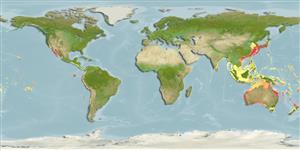>
Centrarchiformes (Basses) >
Microcanthidae (Stripeys)
Etymology: Microcanthus: Greek, mikros = small + Greek akantha = thorn (Ref. 45335); strigatus: Name from Latin 'strigatus' for strigate, referring to the transverse bands or streaks of colour.
More on author: Cuvier.
Environment: milieu / climate zone / depth range / distribution range
Ecologia
marinhas; estuarina associadas(os) a recifes; oceanódromo (Ref. 51243); intervalo de profundidade 1 - 140 m (Ref. 58302). Tropical
Indo-Pacific: East Asia (southern Japan, Korea, the eastern coast of China, Taiwan and Hong Kong), Hawaii and Western Australia.
Tamanho / Peso / Idade
Maturity: Lm ? range ? - ? cm
Max length : 16.2 cm FL macho/indeterminado; (Ref. 131261); peso máx. publicado: 135.00 g (Ref. 131261)
Descrição suscinta
Chaves de identificação | Morfologia | Morfometria
Espinhos dorsais (total) : 11; Raios dorsais (total) : 15 - 17; Espinhos anais: 3; Raios anais : 13 - 15. This species is distinguished by the following set of characters: coloration - fifth body stripe inflected toward the anal fin origin at an angle of 120-150° (usually 130°); lower abdomen usually with a broken stripe, as a series of 2-5 (usually 3) spots and short dashes (Ref. 123714).
Benthopelagic (Ref. 58302). Inhabits coastal and lagoon reefs, also in dense aggregations under ledges and in caves during the day (Ref. 9710). Also observed in rocky areas and occasionally in harbours, embankments, and coastal ports. Adults often school in large groups. It ranges between 10 and 30 m depth, but can occur as shallow as 0.3 m to as deep as 300 m (Ref. 123714). Young feeds on small crustaceans and algae (Ref. 3921).
Ciclo de vida ou comportamento de acasalamento
Maturidade | Reprodução | Desova | Ovos | Fecundidade | Larvas
Tea, Y.K. and A.C. Gill, 2020. Systematic reappraisal of the anti-equatorial fish genus Microcanthus Swainson (Teleostei: Microcanthidae), with redescription and resurrection of Microcanthus joyceae Whitley. Zootaxa 4802(1):41-60. (Ref. 123714)
Status na Lista Vermelha da UICN (Ref. 130435: Version 2024-1)
Ameaça para os humanos
Harmless
Uso pelos humanos
Pescarias: espécies comerciais; Aquário: Espécies comerciais
Ferramentas
Relatórios especiais
Baixar XML
Fontes da internet
Estimates based on models
Preferred temperature (Ref.
123201): 17.5 - 26.4, mean 23.7 °C (based on 254 cells).
Índice de diversidade filogenética (Ref.
82804): PD
50 = 1.0000 [Uniqueness, from 0.5 = low to 2.0 = high].
Bayesian length-weight: a=0.02344 (0.00909 - 0.06048), b=2.99 (2.76 - 3.22), in cm total length, based on LWR estimates for this (Sub)family-body shape (Ref.
93245).
Nível Trófico (Ref.
69278): 3.0 ±0.35 se; based on food items.
Fishing Vulnerability (Ref.
59153): Low vulnerability (10 of 100).
Nutrients (Ref.
124155): Calcium = 81 [39, 129] mg/100g; Iron = 0.685 [0.418, 1.164] mg/100g; Protein = 18.6 [17.4, 19.7] %; Omega3 = 0.143 [0.086, 0.239] g/100g; Selenium = 34.9 [17.7, 67.9] μg/100g; VitaminA = 64 [17, 233] μg/100g; Zinc = 1.63 [1.11, 2.35] mg/100g (wet weight);
